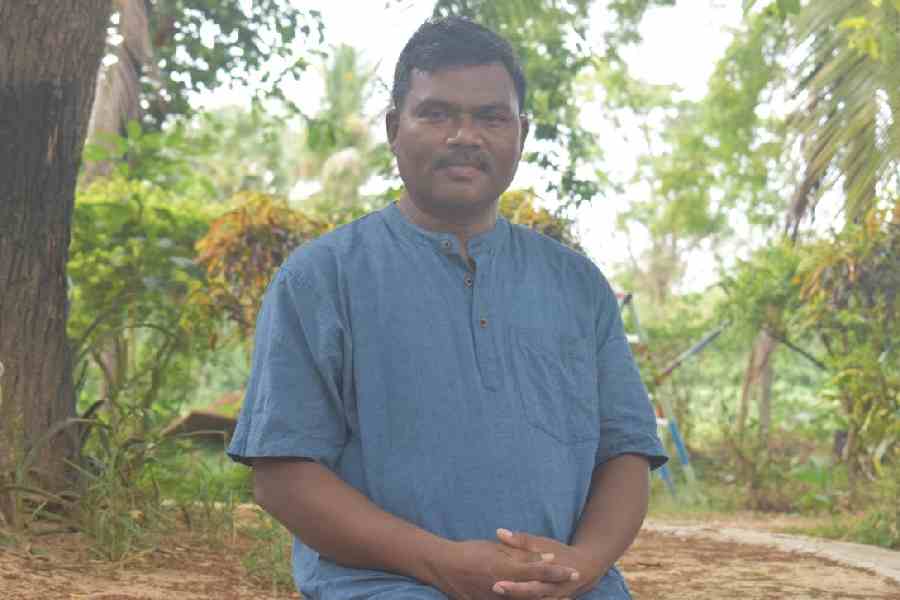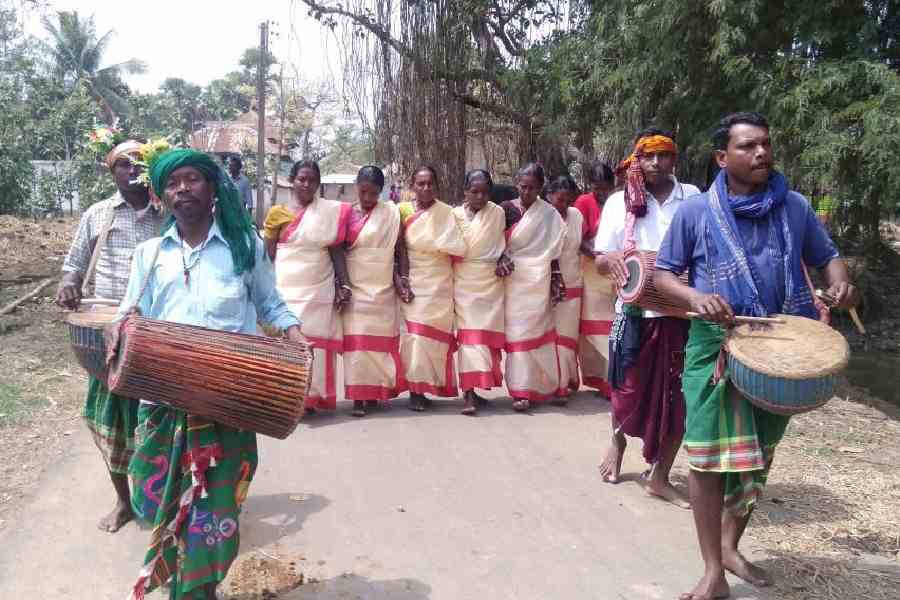When Boro Baski was only a boy, he heard his mother sing a song wherein a brother tells his sister, “Let’s build a bridge on the Ajay river. We will then sit by the river and revel in the sound of each car passing by.” Years later, Baski recalls the olden song and finds his community’s history hidden beneath it.
One evening at Calcutta’s Jadunath Bhavan Museum and Resource Centre, Baski and a handful of others from Birbhum’s Bishnubati village performed Santhali songs. Dressed in the Santhali attire panchi, Baski played the flute and Bimal Baski played the dholak while the ghungroos on his feet jangled away. Young women, dressed in panchi parhat, sang songs of migration, of the Santhali way of life and history, far removed from anything that finds place in history textbooks.
Songs — sohrai, dong and lagre — made up of verses no more than four to six lines. Most of them pulled from community memory, dateless, authorless, rolling from one generation to another.
Boro Baski is president of the Ghosaldanga Bishnubati Adibasi Trust, an NGO based in Bolpur and working for the development of the Santhali people. Some days after his talk at Jadunath Bhavan, he spoke to The Telegraph from his Ghosaldanga office.

Boro Baski, president of the Ghosaldanga Bishnubati Adibasi Trust, an NGO based in Bolpur. Pic courtesy: Boro Baski
Back to the song about the siblings. It belongs to a time when many a Santhali village was moved just like that to build a bridge. This song becomes a testament to how Santhals have always held on to hope and remained joyfully resilient even in the face of struggle and uprooting. The river itself is a feared thing, a boundary of sorts. Santhals were warned by their ancestors not to cross the river, for beyond it lived the Other. Baski says, “To think that circumstances would force these very people to disregard ancestral warnings and settle on the banks of the same river.”
The Santhali migration had started after the Hul rebellion of 1856. Driven by hunger or fear of the police, urged by Christian missionaries or tempted by British officers for a spot of work at railroad construction sites or tea gardens, the population simply moved and kept moving.
“This wasn’t just walking,” Baski says, “many spent their entire life on the road.” He talks about people from places such as Berhait, Bhognadih, Bhagalpur and Sahebganj in the old Santhal Parganas who walked eastwards. The Ganga, untamed by human interventions, stood in their way like a giant obstacle. And then they came upon the Rajmahal Ghat. Another song goes thus: “People are gathering at Rajmahal Ghat. We can hear the whistles, like the humming of bees. Everyone seems to be tangled in the river’s hyacinth.”
Baski continues, “Those from Maheshpur, Pakuria and Amrapara — in present-
day Jharkhand — turned away from the daunting task of crossing the Ganga.” These people started walking southwards, along the rail tracks freshly laid in
Burdwan and Sahebganj, till they came upon the Boramuni or Brahmani river in Odisha.

Santhal dance at Bishnubati village in Birbhum. Courtesy: Boro Baski
Now, rivers have never been allies to the Santhals. So it is natural that the feat of crossing them should be carefully preserved in their songs. Here’s one: “Sands are sparkling on the banks of the Boramuni. Dusk came rolling before we could cross it. Mother, if we were branches of a tree, we could simply float across. Mother, if we were leaves of a tree, we could simply bend across. If we were lotus leaves, we could be reborn and cross the river.”
A lot of these songs are sung by the people of Bishnubati, especially women. Says Baski, “People in our village came from the west, they did not go towards the north of Santhal Parganas. They came from Deoghar, Jamtara, Manbhum... Then they entered Birbhum. They settled in the Bolpur area.”
He continues, “While walking, the Santhals would often set up their habitation near a river or beside a forest. They would live off that land for a few weeks or months, give birth, have a family and then they would move on.”
Santhali songs are a direct reflection of the singers’ social and material concerns. They are suffused with the spirit of nature, hills, mountains, rivers, animals and human habitation. Baski says, “Our music is about our lives but we cannot separate it from the spirit Bonga, who we believe is always among us, everywhere.”
Santhali songs belong to an oral tradition, which according to Baski, has so far eluded the interest and scrutiny of researchers. “People from outside our community cannot come and study our songs because they need to know the language,” says Baski.
His own interest in them was kindled around the time he started working on the Museum of Santal Culture in Bishnubati, which was eventually inaugurated in 2007. Baski was trying to trace and preserve the Santhal community’s route of migration — and also his own family’s history — when he realised that a lot of the clues were embedded in the legacy songs. Since then, he has written many a paper on the subject and tried to retrace the footsteps of community ancestors.
One song goes thus: “We are many brothers, we are served rice on tamarind leaves. Thus we eat and drink our share of happiness from the flowing river of life.” Baski points out that the Santhali language is riddled with metaphors. “There might
be layers of meaning hidden beneath it but it is also what you understand from it,” he adds.
He recites the lyrics of another song. It goes, “Bijoypur, Bijoypur, let’s go back to our country, Bijoy. We have some coins tied to our gamchha, let’s go back to our country, Bijoy.” On being asked where Bijoypur is, Baski pauses, then replies, “I need to check.” Perhaps he means to say it does not matter, that all those who sing know where Bijoypur is, a land their soul yearns for.
Another song, wherein a husband asks his wife: “Dear, we have crossed the Damodar river and the Mayurakshi river. How far is the Telkupi Barni Ghat?” The Telkupi Barni is on the Damodar where Santhals offer their last rites. The song continues, the wife tells her husband, “You have the book in your left hand and the pen in your right hand, dear. Open it and see how far it is.” It is very unlikely that the Santhali couple would have had any knowledge of letters, says Baski.
The song is telling nevertheless, not a little because it is representative of a condition endemic to an entire community for many generations now.










